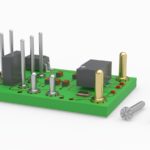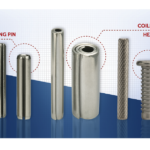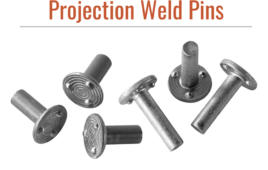Article courtesy of Mill-Max Mfg. Corp.

A press-fit barb for non-plated through-holes. Many pins, receptacles, and spring-pin connectors use this design for retention purposes, in insulators or plastic housings.
Often the products that we take for granted are critically important and imperative to safety. For example, the quality of the fasteners that secure the skin to the airframe on an aircraft is integral because failure could be catastrophic.
The same can be said about the press-fit pins and receptacles applied to interconnect electronic modules. A press-fit connection is one where a contact terminal is pressed into a printed circuit board or PCB and a receptacle serves as the outlet.
These components fasten electronic applications that may provide power to critical equipment and technology — sometimes even to life-saving devices.
In fact, the electronic circuitry interconnected by press-fit pins and receptacles is so broad in application that their role in system performance significant to our everyday life. Individual pins and receptacles may be used for the transmission of signals from power-on down to a logic level. This is why the design and manufacture of press-fit pins and receptacles must include incredible attention to detail.
There are two main types of press-fit pins: a solid pin that has a solid press-in zone and a compliant pin, which offers an elastic press-in zone. Press-fitting uses material displacement, where the pin deforms both the mating hole shape and its diameter. Compliant press-fit pins are the exception as they conform to the hole size as they’re pressed in.
Press-fit pins and receptacles are the most versatile types of interconnection components for electrical and electronic applications and typically are categorized into two distinct categories.
1. Those used for PC boards with plated through-holes (solderless press-fit)
2. Those used for non-plated through-holes, such as bare PC board holes, plastic housings, and insulators
There are also solderless press-fit pins and receptacles which are used in applications where soldering is unreliable or economical, such as thickly printed circuit boards and backplanes.
Typically, press-fitting is just the more efficient manufacturing solution for:
- Bringing power or control signals onto surface-mount technology (SMT) boards via cable, discreet wires, or a daughter card
- Board stacking applications
- Adapter boards for footprint translation (useful when a chip is converted from a through-hole to an SMT package)
When pressed into plated holes on circuit boards, a properly sized hole and press-fit will form a gas-tight connection. This gas-tight connection provides a reliable electrical interface that’s characterized by stable impedance and no oxidization.
However, since applications vary, the physical configurations of how the pins and receptacles mount and function also vary.
Purpose and functions
Pins or receptacles, whether used individually or in pairs, can be useful to terminate a single wire to a PC board. Used in groups, press-fit pins and receptacles are ideal for applications such as:
- Daughterboard to a PC motherboard
- Component to a PC board
- Module to a PC board
- Cable to a PC board
- Cable to cable
- Fuse
Applications include in power, control functions, signal, data, and radio frequency. Different sizes are also available to suit various form factors.
The approach to press-fit pins and receptacles is unique, applying specialized precision-machined pin technology, which offers multiple advantages over stamped-and-formed connectors. Stamped-and-formed is a manufacturing process where the pins and sockets are stamped out of a sheet of flat metal and then formed to a specified shape.

A press-fit knurl for non-plated through-holes. Here, vertical serrations are machined around the diameter of an interconnect pin, which provides a retention feature for press-fitting in a non-plated PC board hole or insulator. It also prevents the rotation of the pin.
Precision-machined pin technology allows large pieces of material to be shaped into extremely precise parts that meet exact specifications — which is important for miniature press-fit pins that must fit a specific application. This process may involve high-speed turning, drilling, milling, and cutting operations.
For example, high-quality, precision machining can turn pin diameters as small as .008″ and as large as .250″ in diameter.
Advantages of specialized precision machining include:
- Seamless construction that prevents contact contamination from wave or reflow soldering
- Specialized press-fit feature geometries (such as triangle, square, hexagon, or octagon, etc.) to meet the hole-size requirements of specific applications
- Lead-in countersinks on pin receptacles to facilitate the pin alignment
- Pin and receptacle shells are typically brass alloy, 360 1⁄2 hard, for strength, conductive, and thermal properties
- Multi-finger beryllium copper contact clip scores the mating device lead to gas-tight electrical connections, providing the ideal power and force distribution
- Two-piece receptacle construction (shell and contact clip) allows for cost-efficient plating combinations for high-quality solderability and conductivity
Of course, the quality and construction of pins and receptacles can vary considerably depending on the manufacturer. To ensure reliability, press-fit pins and receptacles should be machined to tight tolerances and plated with metals that provide the highest possible conductivity and corrosion protection.









Tell Us What You Think!